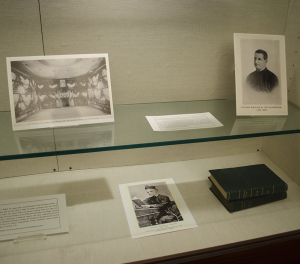
A new Lauinger LIbrary exhibit on the third floor honors Jesuit heritage at Georgetown and will be open until the end of February.
Lauinger Library opened a new exhibit last week on its third floor honoring the Jesuit heritage of Georgetown University.
The exhibit, titled “The Woodstock Theological Library: The Jesuit Heritage of Georgetown University,” is located in both the Kerbs Gallery, which is on the third floor of the library between the Circulation and Reference Desks, and the Woodstock Theological Library on the Lower Level.
The Kerbs Gallery exhibit focuses on the history of the Woodstock Theological Library, beginning from its founding in 1869 as part of the Woodstock College, which was a Maryland Jesuit seminary from 1869 to 1974, to the present-day.
Amy E. Phillips, the Woodstock Theological Library Rare Materials Cataloger, was one of the main organizers of the exhibit.
“The exhibit is a look at the early founding of the Jesuit Maryland province,” Phillips said. “The Jesuits were educated at Woodstock College, which was founded in 1869. I took some images from the resources that were used in the founding, such as a map of the farm they bought that would become the college – I showed the first librarian of the Woodstock Library – and also some of the scholarship that was produced out of Woodstock.”
Phillips said the preserved scholarship, particularly the Woodstock Letters, revealed a significant amount about the workings of the Jesuits around the world. The letters detail the Jesuit history and expansion from the late 1800s on.
“The Woodstock letters began as correspondence between the Jesuits about what they were doing,” Phillips said. “Then, as they expanded their missions in China, Japan and Latin America, [the letters] became more extensive. As a result, it is a look into what Jesuits from the United States were doing in the world, and also takes on certain intellectual character by documenting some of the theological discussions that they were having and researching.”
The exhibit on the Lower Level of Lauinger focuses on a different aspect of Jesuit heritage, namely the role of Mary as an icon and symbol in Jesuit tradition. The display takes inspiration from a similar exhibit titled “Picturing Mary: Women, Mother, Idea,” currently on display at the National Museum of Women in the Arts.
Woodstock Theological Library Director J. Leon Hooper, S.J., was encouraged to put together the display to portray the important role Mary has for Jesuits.
“The collections aim to point out the link between devotion to Mary and how it carried over into the theological considerations, especially in the 19th century debates about the innocence of Mary and the Immaculate Conception, as well as to demonstrate how central the image of Mary is,” Hooper said.
The display includes various depictions of Mary, scholastic arguments, images and documents dealing with Jesuits and the debate regarding the Immaculate Conception. The exhibit also includes the first printed edition of Saint Ignatius’ “Spiritual Exercises,” printed in 1548.
Hooper said the exhibit carries a special relevance to the Jesuit founder, St. Ignatius of Loyola, whose work inspired the founders of Georgetown University.
“Ignatius was a soldier and knight, whose injury by cannon ball caused him to read about lives of the saints and gospels,” Hooper said. “He hardly missed a beat from being a knight for a secular ruler to being a knight for Christ, and Mary is very central in all of that. The Spiritual Exercises are meditations and exercises, in which the central image is Christ the king calling him [Ignatius] to serve in trying to win back the world for God. Every one of the exercises has prayer to Mary that this will be fulfilled.”
The exhibits opened at a key moment, a few days after Jesuit Heritage week, which took place at the end of January and celebrated the Jesuit history of Georgetown.
Associate Professor Fr. William C. McFadden, S.J., said the exhibit plays an important role in educating viewers on the history and foundations of the university.
“The exhibit is part of a celebration of history,” McFadden said. “At a university, a library is special in that it captures in some sort of record way the history. You’d certainly want libraries to be a central aspect in any kind of celebration of that sort.”
Phillips said the exhibit will help celebrate the unique roots of the university.
“It is important to know our foundations and our particular unique Jesuit character,” Phillips said. “The life of the Jesuits, which was always about the whole person and pioneering work in both spiritual psychological growth and formation, as well as very rigorous academic training .”
Lydia Bubniak (SFS ’18) viewed the exhibit and said that it is an excellent way to keep students cognizant of Georgetown’s Jesuit roots.
“Georgetown was founded on the idea of caring for the whole person,” Bubniak said. “Reminding students of the original Jesuit ideals will result long-term in a more caring student body and alumni who seek to use their knowledge to change the world in a positive way.”
Gina Kim (SFS ’18) looked at the exhibit and said she saw the importance of embracing the identity of Georgetown University.
“Talking to my older friends, something they have cited as important is the emphasis Georgetown puts on the care for the whole person,” Kim said. “I believe our Jesuit identity helps create a spirit of Georgetown that I wasn’t aware of while applying to colleges, but I’m really glad I found. For me, I would be not only interested in learning about Jesuit history, but [also about] Georgetown’s history of tolerance and ability to be open-minded in a changing world.”
The exhibit will remain open for viewing through the end of February.














